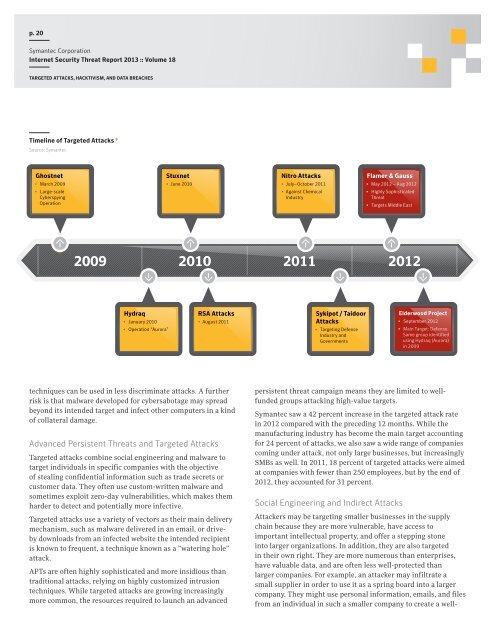internet security tHreAt rePOrt GOVernMent 2013
internet security tHreAt rePOrt GOVernMent 2013
internet security tHreAt rePOrt GOVernMent 2013
Create successful ePaper yourself
Turn your PDF publications into a flip-book with our unique Google optimized e-Paper software.
p. 20<br />
Symantec Corporation<br />
Internet Security Threat Report <strong>2013</strong> :: Volume 18<br />
TaRgETEd aTTaCkS, haCkTIVISM, aNd daTa bREaChES<br />
Timeline of Targeted attacks 9<br />
Source: Symantec<br />
Ghostnet<br />
• March 2009<br />
• Large-scale<br />
Cyberspying<br />
Operation<br />
2009<br />
Hydraq<br />
• January 2010<br />
• Operation “Aurora”<br />
Stuxnet<br />
• June 2010<br />
2010<br />
RSA Attacks<br />
• August 2011<br />
techniques can be used in less discriminate attacks. A further<br />
risk is that malware developed for cybersabotage may spread<br />
beyond its intended target and infect other computers in a kind<br />
of collateral damage.<br />
Advanced Persistent Threats and Targeted Attacks<br />
Targeted attacks combine social engineering and malware to<br />
target individuals in specific companies with the objective<br />
of stealing confidential information such as trade secrets or<br />
customer data. They often use custom-written malware and<br />
sometimes exploit zero-day vulnerabilities, which makes them<br />
harder to detect and potentially more infective.<br />
Targeted attacks use a variety of vectors as their main delivery<br />
mechanism, such as malware delivered in an email, or driveby<br />
downloads from an infected website the intended recipient<br />
is known to frequent, a technique known as a ”watering hole”<br />
attack.<br />
APTs are often highly sophisticated and more insidious than<br />
traditional attacks, relying on highly customized intrusion<br />
techniques. While targeted attacks are growing increasingly<br />
more common, the resources required to launch an advanced<br />
Nitro Attacks<br />
• July–October 2011<br />
• Against Chemical<br />
Industry<br />
2011<br />
Sykipot / Taidoor<br />
Attacks<br />
• Targeting Defense<br />
Industry and<br />
Governments<br />
Flamer & Gauss<br />
• May 2012 – Aug 2012<br />
• Highly Sophisticated<br />
Threat<br />
• Targets Middle East<br />
persistent threat campaign means they are limited to wellfunded<br />
groups attacking high-value targets.<br />
Symantec saw a 42 percent increase in the targeted attack rate<br />
in 2012 compared with the preceding 12 months. While the<br />
manufacturing industry has become the main target accounting<br />
for 24 percent of attacks, we also saw a wide range of companies<br />
coming under attack, not only large businesses, but increasingly<br />
SMBs as well. In 2011, 18 percent of targeted attacks were aimed<br />
at companies with fewer than 250 employees, but by the end of<br />
2012, they accounted for 31 percent.<br />
Social Engineering and Indirect Attacks<br />
2012<br />
Elderwood Project<br />
• September 2012<br />
• Main Target: Defense.<br />
Same group identified<br />
using Hydraq (Aurora)<br />
in 2009<br />
Attackers may be targeting smaller businesses in the supply<br />
chain because they are more vulnerable, have access to<br />
important intellectual property, and offer a stepping stone<br />
into larger organizations. In addition, they are also targeted<br />
in their own right. They are more numerous than enterprises,<br />
have valuable data, and are often less well-protected than<br />
larger companies. For example, an attacker may infiltrate a<br />
small supplier in order to use it as a spring board into a larger<br />
company. They might use personal information, emails, and files<br />
from an individual in such a smaller company to create a well-


